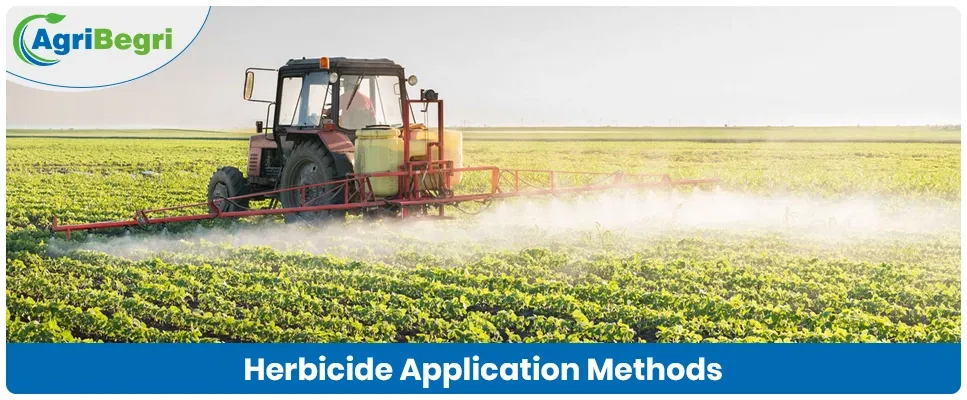Would you invest your hard-earned money in a weed control system that wasn't well planned and executed? A weed management campaign that provides visible results requires the correct choice of herbicides, along with the proper application method. You can protect your crop health, save input costs, and extract higher yields by understanding different herbicide application methods.
In our country, crops such as rice, wheat, and cotton face constant competition from weeds. Through proper application, you can expect results on targeted weeds during the right growth stage. If the type of herbicide and application methods are not in sync, then resources are wasted on a larger scale.
If you are encountering a weed problem in your farm, then don’t worry! Here we have got your back. Read this ultimate guide on herbicide application methods and reduce crop damage caused by toxic and annoying weeds.
Various Types of Herbicide Application Methods: Manual, Knapsack, and Power
Spray application is the most widely used method for applying herbicides. Its popularity is credited to its effectiveness and uniform distribution of herbicide over the entire crop area.
You can see your fellow farmers commonly using manual sprayers or knapsack sprayers in smaller or medium-sized farm areas. On the other hand, larger farms generally rely on power sprayers to swiftly cover wider areas. For contact herbicides, liquid sprayers are more preferable.
In crops like soybean and cotton, where dense leaves can block spray penetration, uniform coverage is most essential. You can also adjust the spray pressure, droplet size, and nozzle type to achieve complete efficiency. If not done properly, then it may result in wasted herbicides.
This further leaves unaffected patches of weeds that survive the weed control drive. For best results, spray in the early stages, when weeds are small and in the active growth phase. This ensures the herbicides are easily and effectively absorbed.
Manual Sprayers:
Manual spraying with hand-held sprayers is suitable for small fields. These hand-held manual sprayers are extremely precise and can target the weeds with the possibility of controlled herbicide dosage and minimal chemical waste. This makes them highly beneficial for vegetable crops.
Knapsack Sprayers:
Knapsack sprayers are actually affordable and versatile in use. They are commonly used for paddy and maize fields. You can prefer them for their ability to maintain uniformity in spray distribution. They can also be easily carried on the back and are sufficient for small to medium-sized fields.
Power Sprayers:
Power sprayers are those that can be worn on your back. They cover larger crops, such as sugarcane or wheat. High-pressure sprays and quicker large area coverage are their advantages. They have an additional ability to penetrate denser crop canopies.
Tractor-mounted Sprayers:
These sprayers are suitable for large, mechanized farms that span extensive acres. They are very effective and time-saving. They can exceptionally cover wider areas in no time and are able to maintain consistent pressure. They do this by having an automatic pump control. They significantly reduce manual labor.
Granular Herbicides: How They Work and Where to Use Them
Granular herbicides are seen in solid forms, as particles that can be directly applied to the soil. Granular vs liquid herbicides are often compared side by side, for choosing the right method. Granules provide a slower release into the soil, making the herbicides effective. This controls the weeds even before they emerge.
Granules are specifically useful in crops like groundnut and rice. A granular herbicide study by ICAR (2024) proved that granular herbicides are successful in paddy cultivation. Granular application does not require water or other special aids for mixing. You can apply granules manually with your bare hands or simple mechanical spreaders. Granules rarely drift, which makes them effective even in windy conditions.
They have also been proven suitable for uneven farmlands where uniform and even spraying is difficult. Granules work best in moist soil, where they can gradually dissolve and release active ingredients at a prolonged pace to kill emerging weeds. However, granules cannot be effective on dry soil. Therefore, setting the application time before or after irrigation is very critical.
“Granular vs liquid herbicides are often compared side by side. Granules are mixed into the soil and provide a slower release. Liquid herbicides on the other hand, are used in post-emergent phases and directly applied on the weeds.”
Other Methods of Applying Herbicides
Apart from sprays and granules, expert farmers also utilize special types of herbicides application methods to gain better results.
Here are a few additional herbicide application methods that contribute to a proper weed control.
Soil Incorporation:
To understand soil incorporation, let's consider an example from cooking. When making tea, you don't just add tea and sugar to the milk and then simply boil it. Stirring the mixtures ensures a better tea.
Similarly, soil incorporation involves adding herbicides to the soil and thoroughly mixing them. This ensures a complete control on weeds. The other advantage of this process is that the herbicide is distributed evenly.
Wicking:
If you dip one end of the cloth in a liquid, the cloth absorbs the liquid from one side and acts as a bridge, supplying the liquid towards the other end. The wicking method in farming works on the same basic principle. Farmers use a rope or a piece of cloth to soak in the herbicide.
The same wet piece of cloth or rope is then used to wipe the tall weeds. Wicking is a popular herbicide application method for tall weeds. With this herbicide application method, a lot of herbicide waste and crop damage can be avoided.
Spot Treatment:
When you see a single dark spot on your shirt, do you wash the entire shirt or treat just that one spot? Spot treatment is exactly the same, but in terms of farming, if you spot weeds in one corner of the farm, you spray herbicide on that specific spot and not the entire farm.
It is a precise herbicide application method that serves very specific application needs. By avoiding widespread applications, you can also save money and save your valuable crop from unnecessary injury. This method is extremely useful in large orchards and vegetable fields, where patches of weeds can be seen.
All these herbicide application methods can be considered as “effective hacks” in modern terminology. They are quick and extremely effective treatments that can be relied upon whenever needed.
Choosing the Right Herbicide Application Methods for Your Field
Choosing the most effective herbicide application method for farmers can depend on several factors. The factors like the weed growth stage, soil conditions, and crop types dictate that choice. A smart farmer uses application methods to his advantage.
For example, granules may leach in a sandy soil, reducing effectiveness. On the other hand, clayey soil has the potential to hold the herbicides for a longer duration. Granules are used when the availability of water is uncertain.
Apart from that, timing is an extremely crucial factor. Pre-emergent herbicides are applied before weeds appear, while the post-emergent category of herbicides works by targeting visible weeds.
Another important factor is the size of the field, in addition to the crop. Choosing your application methods depending on the size of your land and crop type is a powerful tactic. For example, knapsacks are efficient for smaller paddy fields, but for a larger wheat farm, you might need a tractor-mounted sprayer.
Conclusion:
A knapsack sprayer herbicide use can meet the needs of small farms that produce pulses and vegetables. Meanwhile, tractor sprayers might be required for larger farms of sugarcane, maize, and wheat.
Additionally, standing water crops like paddy or rice can benefit from granular herbicides. Spot treatment methods can yield effective weed control results on patchy weeds while saving costs.
Furthermore, taller weeds that grow above the crop’s height could be treated using the wicking method. Lastly, soil incorporation is a highly used method for even herbicide distribution.











